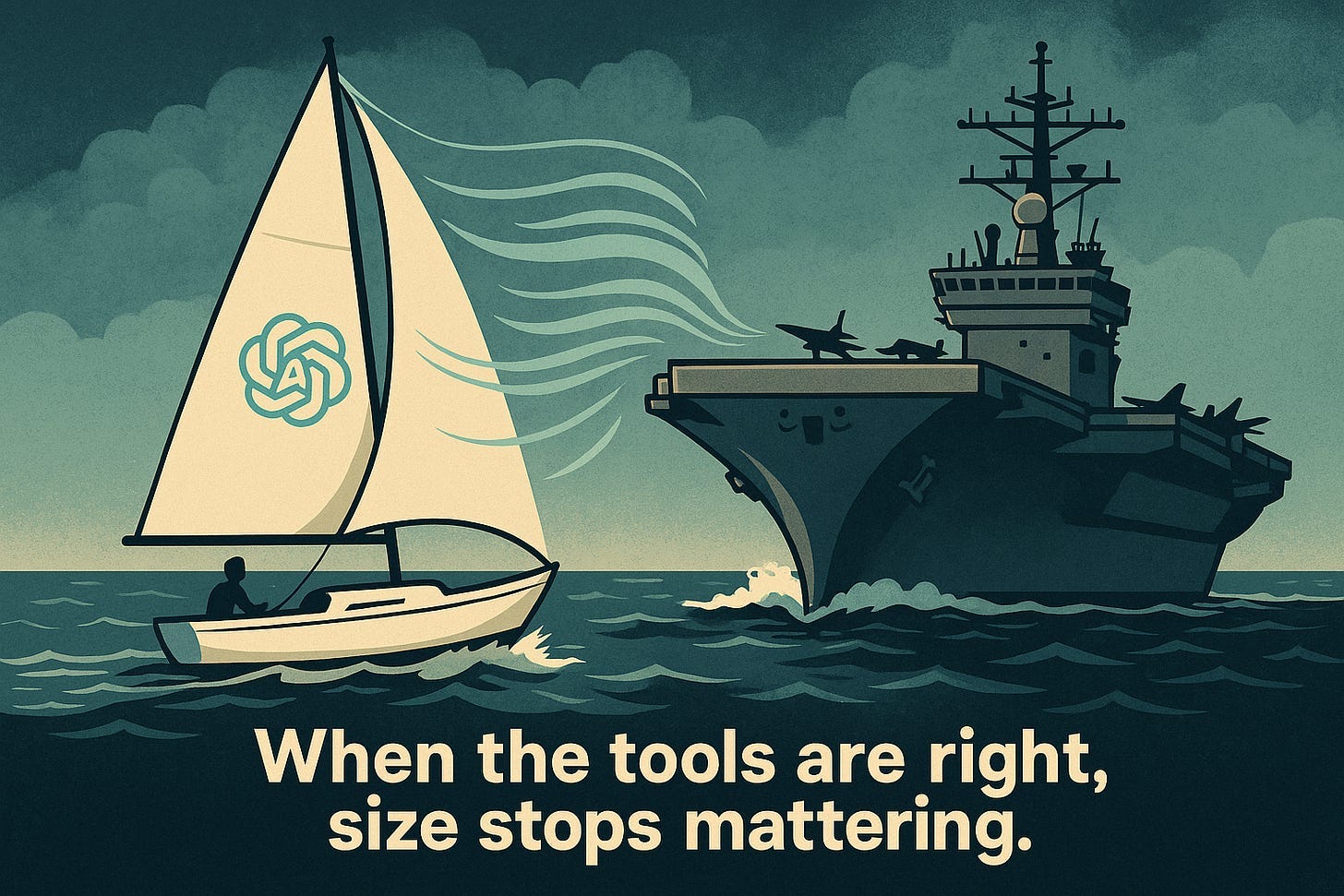Today we are joined with
. He writes Leadership in Change, providing tools for the modern leader to achieve lasting success.Before we continue, you can check his newsletter below 👇
Joel will take you to explore from here.
The first time I used AI to summarize a 30-page study, I felt like I’d just discovered magic.
What used to take an entire afternoon, reading, highlighting, extracting, and synthesizing, now took a few minutes. But it wasn’t just about speed. It was about access. Suddenly, the kind of research, synthesis, and strategic thinking that used to be reserved for well-funded orgs and high-powered writers with a full research team became something I could do with a good system and a few solid prompts.
For leaders, writers, and organizations who don't have a staff of analysts, researchers, or global consultants… AI has changed the game.
But here's the part that's easy to miss:
AI doesn’t level the playing field by accident.
It only does it if you understand it and know how to use it.
The Resource Gap Was Always Real
For decades, people have faced the same wall:
You’ve got vision, but not the budget.
You’ve got voice, but not the platform.
You’ve got strategy in your head, but not the time to turn it into a polished message or multi-channel campaign.
The playing field has never been level, especially internationally. Larger corporations and well-resourced individuals had researchers, data analysts, consultants, writers, marketers, and campaigns that moved faster than what most of us could cobble together on nights and weekends.
And now?
Those capabilities are available to anyone who learns the tools.
With AI, you can:
Pull global case studies in minutes.
Translate content across languages instantly.
Summarize 100 pages of audience feedback before lunch.
Get 10 different ideas for a title for your next piece.
But only if you think well before you prompt.
And here's where it gets practical:
If you want to start strong, here are a few prompts I've personally found useful:
"Summarize this research paper in plain language, including a summary at the end with key findings." - Make sure to upload the data as a document or table of data.
"Give me 3 headline options that feel bold, emotionally intelligent, and mission-driven, my audience is [INSERT HERE]"
"Rewrite this paragraph to sound clearer without losing strategic tone, I need it to sound more personal but still professional."
"List potential risks I might overlook in a board presentation about [X]."
"Turn this outline into a 10-minute team talk that balances clarity and warmth."
You don't need a perfect prompt.
You need a learning posture.
The more specific your ask, the more useful the output becomes.
What You Must Realize Now Before It’s Too Late
The greatest risk right now isn't being left behind by AI.
It's letting others define how AI will be used, while we sit on the sidelines, unsure if it's "okay" to use it or if we are up for it. Or maybe, assuming we already understand it.
The question we should be asking is: “Am I using this to its full potential?”
Because the tools are here. And used smartly, they give emerging voices a shot at clarity, reach, and insight that used to take teams of 10+.
For example:
Writers can use AI for editorial prep, voice tightening, and audience-tailored adjustments.
Leaders can generate board-ready summaries, talking points, and SWOT analyses.
Strategists can model outcomes or simulate stakeholder reactions before a big pivot.
It’s not just helpful. It’s revolutionary.
But only when your wisdom leads the process.
Don’t Confuse Access with Impact
Here’s the trap: AI makes everything feel fast, so it’s easy to get lazy.
Lazy in thinking.
Lazy in discerning.
Lazy in revising.
As a result, you might publish more… without saying anything real.
So yes, AI is the great equalizer. But only for those who truly understand how to use it to boost their expertise, skills, and creativity.
When you use AI to supplement deep thinking, not avoid it, it becomes your sharpest competitive edge. Not because it replaces your voice, but because it removes what used to block it.
TL;DR — If You Only Remember This:
AI flattens the playing field, but only for those who get curious, not just fast.
Mission-driven leaders finally have access to world-class support if they learn to wield it.
Impact still belongs to those who think clearly and lead wisely. The tools just speed that up.
Note: If this stirred something in you, subscribe to
for more reflections on leadership, clarity, and tech decisions that actually serve your mission.






This is spot-on. AI isn’t a magic shortcut, it’s a profound amplifier of intentionality and clarity. For me, it’s not about speed or volume; it’s about genuinely extending our capacity to think deeply, strategically, and purposefully. Real impact still relies on thoughtful human decisions, curiosity, and a clear mission. AI is just helping us remove friction, enabling us to focus on the things that matter most. Thanks for clearly articulating the transformative potential of AI, it’s truly a game-changer when we use it intentionally.
Really sharp take. AI alone isn’t the equalizer, it’s how you use it that counts. The tools are out there, but it’s the mindset, curiosity, and purpose that actually move the needle. Loved the reminder that power without direction isn’t progress, it’s just noise.